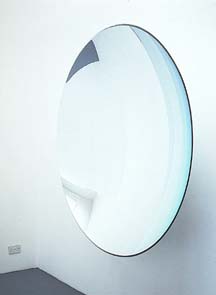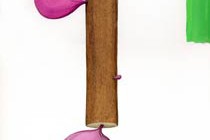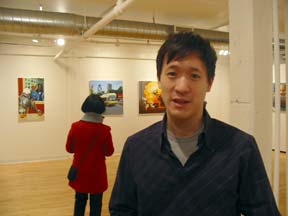At the end of January two Boston venues will have played host to expansive exhibitions by the Welsh artist Cerith Wyn Evans; both the List Visual Arts Center at MIT and the MFA. Wyn Evans’ vehicle for entry at both institutions is a disorientingly large concave mirror. This frontispiece distorts reflections to an extreme degree, including of course, that of the viewer. Reverse, Inverse, Perverse (the title of the mirror at the MFA) has its symmetrical twin, Perverse, Inverse, Reverse at the door to the List. Wyn Evans has described his mirrors as “machines for generating strangeness.” It is true, the concave mirror plays with perception; the extent to which is bounded only by the limitation of the viewer’s engagement with it. As a function of its anatomy, this mirror has the necessity of focusing light to project a clear image some distance from its center. A doubling is taking place. More than generating strangeness, the device generates a sense of the uncanny; just one of the directions we are nudged as we attempt to make meaning.
Entering the exhibition at MIT, the viewer, having taken time to twist and stretch his own distorted visage, the viewer will find himself reflected clearly, upside-down, standing among three exquisite examples of Japanese Scholar’s Rocks. Actually both stone and wood, the rocks, on loan from the MFA, are at eye level upon chest high plinths. While contemplating the ancient nature/culture hybrids an unmistakable murmuring can be heard. The sound is the rumora of a recording from MIT’s museum; archived conversation, utterly banal small talk. The voices would be barely distinguishable from the building’s own sounds were it not for their distinct resonance with the past. High on the wall a single audio speaker emits a thin-husked voice. The recording’s low tone necessitates eavesdrop, begging one to listen closely. What I heard, now whittled down by time was, “pilot’s license . . . that should do him well.” Just a fragment. As the space for listening can accommodate only one person at a time, what one observer is able to discern is his own fragment. In some sense, the sound, a found object to begin with, has been found again.
The elements of Wyn Evans’ aesthetic, in this ante-room and throughout the installation, embrace a convention of singular importance in art as it has developed in the 20th century; the ready-made. In a site-specific response to both the architecture of the List as well as this space’s implication as part of several larger institutions (the Institute itself, the Museum with which it participates, and certainly the broad category of civilization), Wyn Evans has selected pre-existing objects, voices, phenomena, with the purpose of deploying them to their greatest potential. It is in a state of potential that they wait. This work requires the implicit participation of the viewer to become active. In fact, it is what Marcel Duchamp called a “delay” that confronts the viewer. “Delay in glass”; meaning is deferred, interminably future, until you or I flip the switch of engagement and bring it to the present. These fragments are the viewers’ legend (likely synchronous) for the next room of the installation.
If the first room is intimate, the next is like coming upon a vista. In the foreground stands a stack of volumes. The stack is a console, the equipment once used to broadcast WTBS, MIT’s radio station. That station still tantalizes at odd hours at 88.1FM. Here the dark wooden cases and powder-coated metal offer the patina of time. Opposite the turntables, framing a quad, is a plate glass window. White neon renders the title of the exhibition, once as object, once a reflection like subscript on the glass. At the far end of the room, beyond the pendulous black chandelier, is a wall projection.
The projection is provocative, sublime – light generated by two standard slide projectors, marking time with whir and click. Their images are layered photos of jostled men and deep celestial space, titled, The sky is thin as paper here. . .. They keep with the monotone and restraint, but are nonetheless the artist’s hand, right in the substance. While all else in the exhibition has its layering suspended in a potential state, awaiting engagement, these cycling images are complete, nourishment for the vision.
In the final pairing the black chandelier reveals itself to be a deep purple when the bulbs are on. The lights rise slowly and then dim slowly, apparently in a pattern whose source can be read on the wall. Back-lit on a flat monitor is the morse-code, translated form a definition of the word “image,” which commands the chandelier to illuminate in long and short intervals. Like the lights, we viewers are intermittent participants. Our moments of engagement are spliced together by interstices of distraction. Wyn Evans’ spartan selection of stimuli allows those moments to become part of the improvised gathering of information out of which we make meaning.
Roland Barthes, writing in Empire of Signs, proposes that improvisation is part of a mythical duad which surrounds meaning: “A double myth. . .which makes concision proof of art [and]attributes a premium of truth to improvisation.” Describing the haiku, he points to Western reverence for such impressions. Like Barthes’ haiku, Thoughts unsaid, now forgotten. . . plays off these assumptions. As in the myth of meaning, this exhibition is deliberate and spare. Further, any one viewer’s path through the installation is his alone, improvised. And like the haiku, the exhibition, “though quite intelligible, means nothing.”
Cerith Wyn Evans uses artifacts of communication, its technology and its syntax, to enter into dialogue with us. Each installation is rife with avenues of experience; a bricolage designed to challenge the viewer’s capacity for participating in synthesis. If you’ve made it this far, the MFA exhibition, which ends this month, is not to be missed. For myself, I will be sure to catch the next Wyn Evans conflagration whenever it comes this way.
Links:
List Visual Arts Center, MIT
Museum of Fine Arts, Boston
"Cerith Wyn Evans, Thoughts unsaid, now forgotten . . ." was on view at the List Visual Arts Center at Massachusetts Institute of Technology until December 31st, 2004.
"Cerith Wyn Evans" is on view until January 30th in the Foster Gallery of the Museum of Fine Arts.
All images are courtesy of the artist and White Cube.
Thomas Doran is a regular contributor to Big, Red & Shiny.




